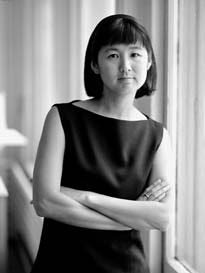Maya Lin, architectural designer and sculptor, blazed across the consciousness of America when, as a 21-year old architecture student at Yale University, she won the design competition for the Vietnam Veterans War Memorial.
Her visionary design, selected from a field of 1,420 entries, inspired interaction between viewers and the memorial. It made no political statement but commemorated the sacrifice and heroism of every service person through engraving the names of all the fallen in chronological order of loss on two highly polished, black granite, intersecting walls. Its silent, massive, shining presence, two V-shaped wings, one pointing to the Lincoln Memorial and the other to the Washington Monument, opened officially to the public November 11, 1982. It has become the most visited monument in Washington, DC and one of the most well-known memorials in the world.
In 1981, her selection stirred reflection, debate, opposition, and intense controversy. By 1989, when her design for the Southern Poverty Law Center’s Civil Rights Memorial in Montgomery, Alabama was completed, Maya Lin was established as a pre-eminent architectural designer.
Over the last few decades, she has executed numerous other architectural projects such as private homes, landscape sculptures and other memorials. Her co-design of the Museum of African Art, Pennsylvania Station, sculptural works such as Topographic Landscape, the Wave Field located at the Francois-Xavier Bagnoud building for aerospace engineering at the University of Michigan, Ten-Degrees North at the Rockefeller Foundation in New York City, Avalanche, Groundswell at the Wexner Center for the Arts at Ohio State University, Columbus, OH, and the traveling Topologies show treat the themes of love of nature, landscape and the environment, while utilizing technological elements.
She draws inspiration from widely diverse sources; her Chinese-American immigrant heritage, Japanese gardens, European multi-use parks such as Denmark’s Norbrow, Hopewell Indian earthen mounds, and American earthworks artists of the 1960s and 1970s. Weaving an American fabric from differing threads, Maya Lin broke opened new avenues and expanded public understanding. Focusing on “how humanity deals with mortality in the built form,” she connects the viewer, through immediate sensory experience, with major historic events. Inspiring thoughtful examination, emotional bonding and the reconciliation of oppositions, Maya Lin’s work has promoted human rights and changed the way people view the world and the events of their times.

